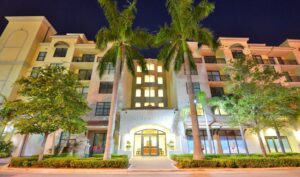
Worthing Place
Note: I’ve been involved with the Urban Land Institute (ULI) for close to 20 years now. It’s a wonderful organization with chapters throughout the world dedicated to real estate and land use. Over the years, I’ve been asked to work with ULI panels to help cities navigate issues and seize opportunities. I’ve had a chance to work in places like Winter Park, Tamarac, West Palm Beach, and Fort Lauderdale. Recently, the City of Deerfield Beach engaged ULI in a community wide discussion about density. I thought I’d share my talk since it focused on our experience with the “D” word in Delray Beach.
The story of density in my hometown Delray Beach can be told through the saga of one project: Worthing Place which is located on Atlantic Avenue in the heart of our downtown. My hope tonight is that the Delray story—what worked and what didn’t– can offer you some insights that might help your city as you move forward.
Worthing Place is a 6- story, 60-foot tall apartment building with some restaurants and shops on the ground floor. It is set back from the street and sits behind a small pocket park which has become a lively space to watch the hustle and bustle of a very busy downtown.
It features 217 units on about 2.4 acres, which works out to roughly 90 units per acre, or three times the current density allowed in our downtown.
The Delray Beach CRA assembled the property in the mid-90s with a goal of creating a mixed-use project that would replace blight with vibrancy. We believed that housing was an essential component to jumpstarting a downtown that had shown some signs of life after a very rough decade in which we experienced 40 percent vacancy and virtually no nightlife. You could have gone bowling on Atlantic Avenue in the 80s and not hit anything.
The RFP was awarded to a team of experienced local developers who agreed to build a public parking garage before breaking ground on the apartments and retail. That offer, to build a garage benefiting the public before building apartments, was seen as a key to the winning bid.
But the size of the project—it’s height and density—split the town into two warring factions.
The project was approved and the city was immediately hit with lawsuits that prevented the project from moving forward. The developers built the garage—as promised, but litigation meant that they could not build the actual project.
When I was elected in 2000, the commission I served on inherited the lawsuits—I believe there were six or seven of them—but we also inherited the division over growth and development that this project ignited in our city.
Delray Beach is a very special place—we guard our charm and strive to maintain the brand of being a village by the sea.
We don’t allow tall buildings, but we do fight over 3 and 4 story buildings and density is a very, very touchy subject.
Mindful of these dynamics and wanting to unify the community after the tough fight over Worthing Place, we decided as a city commission to bring the community together and create a downtown master plan.
We did a massive public awareness campaign to get as many stakeholders to the table for a series of charettes or public meetings where we could brainstorm, draw, share and learn together. Our goal was to plan for a sustainable downtown that managed to be vibrant while being respectful of property rights as well as the look and feel our town.
Our tagline for the effort was “Keeping the Charm” and that was the goal.
Mind you, that’s not an easy task for a city…my idea of charm or of a village by the sea may be very different from my neighbors. Some may want a vibrant, bustling village and others may want a sleepy village. But we tried to work together as a community to come up with a consensus vision and policies to preserve, protect and enhance our downtown.
We produced a large document…but if I had to boil it down to a single theme it would be this: “Design matters more than a random density number.” In cities, we often get hung up on dwelling units per acre. We should be thinking about how projects fit in to the fabric of our communities.
In the master plan process, we learned that density was needed to provide housing opportunities for people who wanted to live downtown, we learned that if we wanted mom and pop businesses to survive, we needed a certain amount of density to support those businesses and we learned that density was better than sprawl in terms of the environment.
But the key message was the importance of design and scale…new development needed to be attractive and ideally enhance the charm and character of our downtown.
What I’m describing is a great aspiration. But it can be hard to achieve because design is subjective.
We came away from the Downtown Master Plan process unified—at least among the few hundred who showed up to participate. But when you have 65,000 people, a few hundred, while good, is not enough to sustain an effort to shape your downtown. So, we worked hard to promote the plan, to educate the public on why density– done well– was important for our community.
And for a while we succeeded.
The city won all the lawsuits relating to Worthing Place and the project got built. It was supposed to be the first mixed-use housing project downtown, but the litigation delayed things and it ended up being among the last to be built.
Many other projects— not nearly as tall and certainly not as dense— were built. There has been a massive amount of public and private investment. And it has paid off.
Downtown Delray has become a regional attraction, with over 100 restaurants, tens of thousands of weekly visitors and a very low vacancy rate.
But success comes with challenges.
Rents have increased from $5-$7 a square foot when I moved here in 1987 to as high as $165 a square foot for prime restaurant space. It’s difficult for mom-and-pop businesses to pay the rent.
When you experience success, it’s not uncommon to want to try and ratchet things back.
So, after I was termed out, a subsequent commission lowered the height limit to 54 feet, 35 feet on the avenue itself, and capped density at 30 units to the acre in most of downtown Delray. There are a few places in town where you can exceed that amount, but by and large density has been capped.
You don’t tend to cap things that you view as virtuous. If density was popular, it would be encouraged not capped. Besides, our language has changed—instead of encouraging density in strategic places to achieve civic goals, we are warning developers about density.
After spending a lot of time, money and effort trying to sell the virtues of density and great design—we stopped engaging residents on these topics and now every election cycle is about the evils of growth and development. We no longer talk about smart growth or good development; we only seem to talk about traffic and whether we have lost our charm.
Density has become a dirty word in a town that used it as a tool to become a national model for how to revitalize a downtown.
Now, I understand the sensitivities…I understand the frustration caused by congestion, even though we experience more traffic driving on multi-lane suburban streets than when we drive downtown where we can use our grid system to get around efficiently.
I am immensely proud of my city and what we were able to accomplish. But I also understand it is not everyone’s cup of tea. And I understand that change cuts both ways: it can be good, it can be not so good. But all in all, I think Delray did a nice job.
We don’t allow big buildings, especially when compared to our coastal neighbors, which allow heights more than twice as tall as we do.
Efforts have been made to limit massing and maintain the human scale that is our calling card. We narrowed US 1 in our downtown to make it more of a neighborhood and less of a highway. We improved pedestrian safety and we have created a year-round economy in what had once been a seasonal town.
But in many ways, even though others think we have done a good job, we are losing the argument.
City planners and new urbanists are often fans of Delray. I’m here, 17 years after being term limited, because ULI views Delray as a positive example.
But as the kids say when talking about relationships—it’s complicated.
When politicians look at our city and see their best chance of being elected as running against what has been achieved downtown because density was used wisely— something has gone awry.
So as Deerfield weighs its next move relative to density, growth and change…I would offer up Delray as a good comp. We are both a success story and a cautionary tale.
We succeeded because we revitalized what had been a declining downtown. The revitalization has stood the test of time—we survived the financial crisis, Covid, competition from other cities and changing tastes. I would argue that density done right—done gently as my friend Juan (Urban designer Juan Mullerat) would say–helps you build wonderful and memorable places.
I commend you for engaging with ULI and inviting the public into this process, much like we did when we crafted our Downtown Master Plan in 2001.
But I would urge you—from experience—to never stop engaging, educating, and learning together as a community. We stopped doing those things somewhere along the way…because after all politicians come and go. But the need to keep dreaming and implementing never goes away. That’s the beauty of cities. You are never done, especially if you get some kind of success. You can’t be complacent. Complacency is a killer.
As a former elected official, I know you can never please everyone. And you can really set your community back by trying. But you can and should take a long-term view and try and move the big rocks.
The best piece of advice I ever got was that elected office is a job to do, not to have.
You need to take some risks to move the needle and make things happen in your city. But you have to bring the community along with you…they have to buy-in and say yes. And they have to keep saying yes. That means a never-ending conversation about the future of your community. That’s the fun part.
I’m a fan of Deerfield Beach, I’m in the Cove for dinner, I love your beach and I used to have an office in town. So, I am rooting for you.
I’ll conclude by telling you what happened with Worthing Place.
It succeeded. It never became the blighted tenement that opponents feared would forever scar our downtown. Instead, it became a catalyst for activity and additional investment.
The restaurants downstairs have become popular spots…the apartments are coveted, and the garage is well-used and a money maker for the city. A few months ago, the company I work for, a family office, bought the building from BlackRock for over $100mm. So, you can see that the project that divided our town has a whole lot of value.
It’s a full circle moment for me and a major investment in our downtown for my company. I’d like to think that density —done well—created an ecosystem that remains an attractive place for people to live, work and play. Thank you for this opportunity and good luck with your wonderful city.




